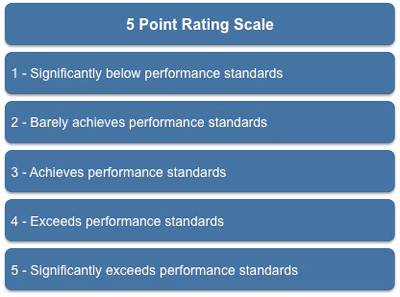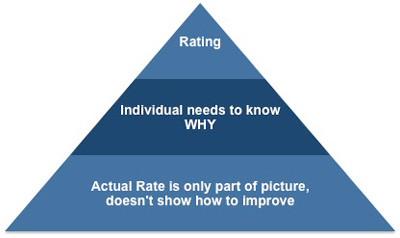Performance Appraisal Rating Scales
A key consideration when gathering performance management data is the way in which performance is going to be rated. Most organizations use a 3, 4, 5 or 7-point scale with the most common being a 5-point scale as shown.
 |
The advantage of using this scale is that you are able to rate people above or below average performance without reaching either of the extremes, which many managers are uncomfortable doing. The fact that the highest and lowest ratings are reserved for exceptional circumstances means that most people are comfortable using this scale.
While 3-point scales do exist they are comparatively rare and are usually unpopular. Similarly, a 4-point scale forces a manager to assign higher or lower than average marks even though they may not feel that this is justified. Some favor it because a manager does not have the option of just selecting the midpoint; they actually have to make a reasoned judgment. However, if the time involved in making these judgments is excessive then this is detrimental to the manager's own performance and can prove unpopular.
You will need to communicate to your team members how the 'midpoint' of the scale is defined. You should do this at the start of the appraisal cycle so that their expectations are clearly set. For example, you could explain that a rating of '3' is awarded when an individual is achieving their targets consistently, displaying the required competencies, and showing commitment as detailed in their job description.
You should ensure that every member of your team appreciates that a midpoint rating does not equate to an indifferent or merely acceptable performance and implies more than just turning up every day. The policy of your organization in terms of awarding merits and promotions based on a midpoint rating needs to be explained to the individuals so that they are aware from the outset of the impact on their remuneration of a midpoint score.
Descriptions of the rating criteria and remuneration policy are usually available from your human resources department. For example:
1 - Significantly Below Performance Standards: An evaluation resulting from performance that consistently and significantly fails to meet the performance standards of the position. The supervisor must contact the Division of Human Resources to initiate a Performance Improvement Plan, which must be completed jointly by the employee and the supervisor.
2 - Barely Achieves Performance Standards: An evaluation resulting from performance that barely meets the performance standards of the position. The supervisor must contact the Division of Human Resources to initiate a Performance Improvement Plan, which must be completed jointly by the employee and the supervisor.
3 - Achieves Performance Standards: An evaluation resulting from performance that fully meets the performance standards of the position.
4 - Exceeds Performance Standards: An evaluation resulting from overall performance that is above the performance standards of the position.
5 - Significantly Exceeds Performance Standards: An evaluation resulting from overall performance that is consistently and significantly above the performance standards of the position.
You can avoid a lot of misunderstandings by making sure that all of your team members are aware of the rating criteria and remuneration policy.
You should also think carefully about the distance between the midpoint of the scale and the other points. To pick a simple example, if a support team member is expected to deal with 40 customer queries per day, at what point would they merit a 'consistently exceeds expectation' rating?
This is a decision for you to make and the important thing is to be consistent. It can be a good idea to base this figure on historical data so that team members see it as realistic and achievable, rather than some arbitrary goal.
You should also take into account that highly effective employees often complain that their managers do not give them sufficient recognition for their efforts. Most high-level performers value being told that their performance has exceeded expectations. If you take this group for granted and fail to give them detailed feedback on their successful performance you risk lowering their motivation and commitment.
 |
Finally, don't get too hung up on the rating aspect of performance factors. It is far more beneficial for the employee to understand why they have scored as they have and to know where the areas for improvement are, than to become preoccupied with any particular performance measure. The most important thing is that there is a clear rationale for each rating, which demonstrates to the employee exactly why that selection was made.
You may also be interested in:
Evaluating Performance Appraisal | Appraisal Data Collection | Evaluating Competencies | Performance Appraisal Rating Bias | Performance Appraisal Reviews | Writing an Annual Performance Summary.



